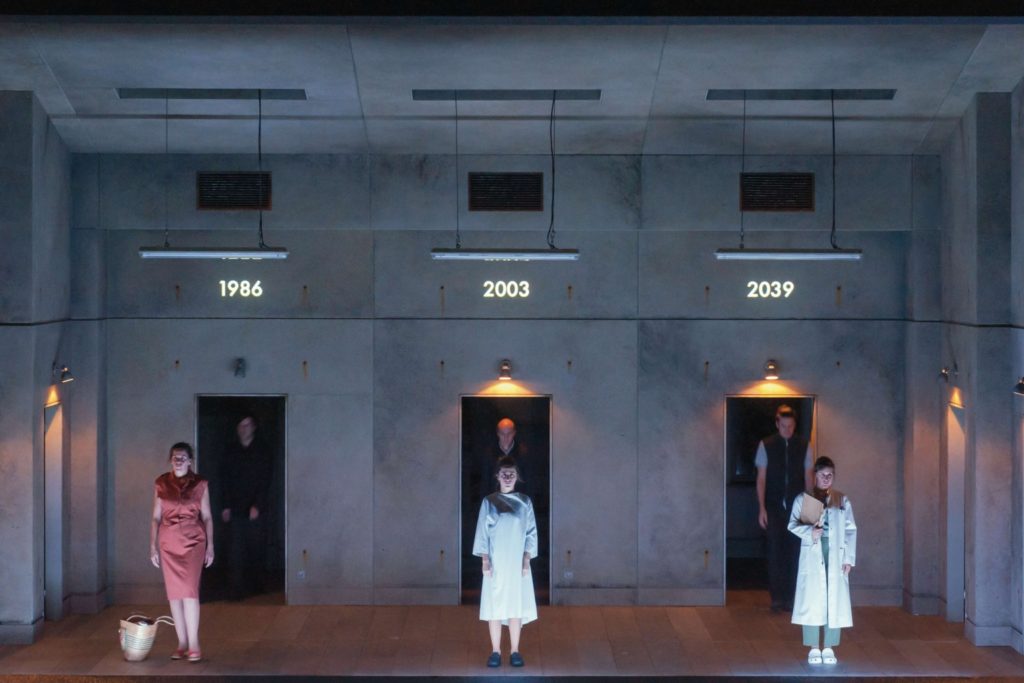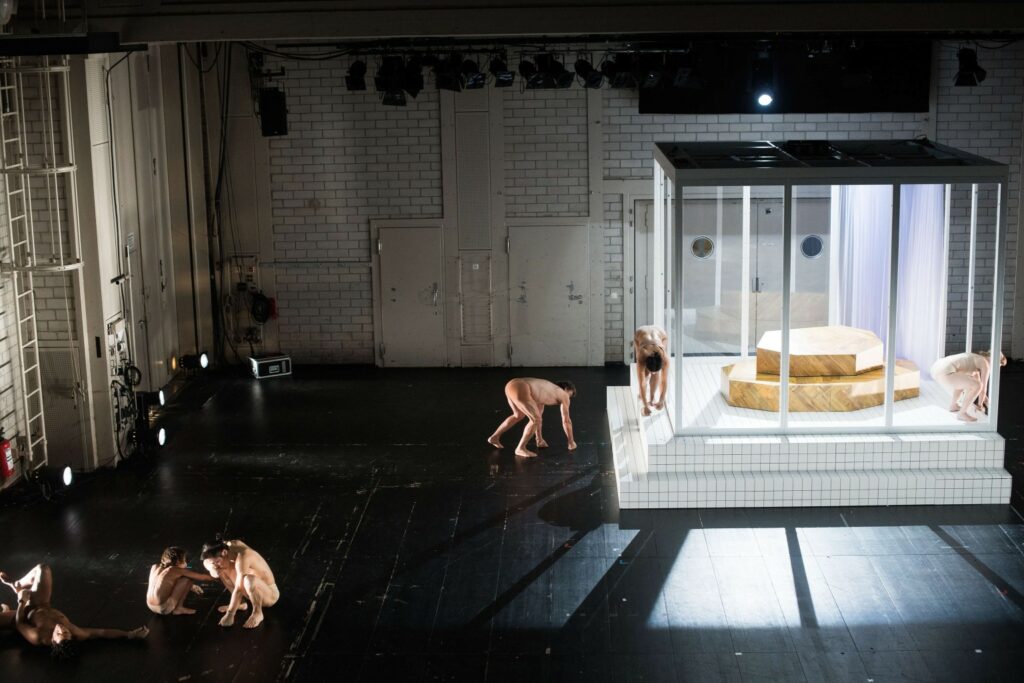Coffee, laptop, stream: Our author has already established a pandemic-style morning routine. Here he chronicles which Theatertreffen streams have helped him start the day – and which ones haven’t.
Dear diary, I’m not really an evening person. I often feel tired, lazy, foggy as the day draws to a close. Perhaps it wasn’t the wisest idea to become a theatre critic, but over the years I have smuggled in countless bottles of Club Mate into the stalls of the city and can power through even the most ambitiously long of Castorf slogs. But shhh, that’s our little secret, dear diary. In this respect, streaming theatre has been highly liberating: I can start my day with a coffee and a play. However, I quickly discovered that this newfound freedom has its drawbacks.
The hyperactive approach to cuts
But first we need to set the scene: my home theatre consists of a laptop plugged into a TV, blinds at half-mast, me sprawled across the sofa and an obligatory caffeinated refreshment. I thought this year’s Theatertreffen could be a good opportunity to spend some quality lockdown time with my partner. I was wrong. Five minutes into Johan Simons’ Hamlet and I’m informed that watching GZSZ would be a better use of a Saturday morning. Thus, I’m left alone to witness the tragic demise of the Danish royal family. At some point, the living room door swings open. “Why is everyone shouting?”, my partner asks worriedly. “BECAUSE IT’S GERMAN THEATRE”, I scream in response.
3sat’s hyperactive approach to cuts in their edit of Hamlet isn’t everyone’s cup of tea. But I, for one, enjoyed the energy of it. As thankful as I am that we at least have streams during this traumatic period of cultural stasis, I admit that they can be rather boring. As an audience member, my eyes typically dart around – sometimes they focus on the action or dialogue, but not necessarily. Spectators can be rather anarchical in their viewing habits – yet this is not and cannot be captured by the authoritarian gaze of the 3sat editing studio. They tell us what to see. Luckily, they do a pretty good job – for the most part.
I miss the long walks home from the theatre in summer with my plus one, where we debrief and discuss into the night. I miss bumping into people in the foyer after the performance. And I certainly miss the Theatertreffen premiere buffets.
Streaming can be a very two-dimensional experience. 3sat at least made an attempt to overcome this technical limitation by occasionally flipping the perspective and cutting to a camera positioned at the back or side of the stage. It’s an experimental approach with mixed results but they definitely get an A+ for effort. In doing so, the performance becomes an artistic object, viewable from all sides. This grants the artwork a sense of depth that otherwise wouldn’t be conveyable on a television screen. It also highlights the theatrical nature of the performance, distinguishing it from TV or film: we see the direction of the performance, the fourth wall, the empty rows, and are thus constantly reminded of the space in which the performance is taking place in.
No clapping, no pretzel, no audience
The proverbial curtain draws around lunchtime and my stream abruptly ends. No overzealous clapping, no pretzel vendor in sight, no audience chitchat – just silence. The post-performance wine is sorely missing and I have an urge to discuss what I have just witnessed. I turn, somewhat reluctantly, to Twitter. I miss the long walks home from the theatre in summer with my plus one, where we debrief and discuss into the night. I miss bumping into people in the foyer after the performance. And I certainly miss the Theatertreffen premiere buffets.

Attempt two, twenty-four hours later: the dress rehearsal recording of Katie Mitchell’s Anatomie eines Suizids is – as expected – far from the polished, cut-heavy product 3sat delivered. A static camera at the back of the theatre films the action, with occasional, haphazard closeups. It’s not always clear who’s talking and much of the facial expressions are stripped away by distance. In a theatre, I would have presumably alternated my attention between the three interlinking stories on stage, granting each one attention and focus at different points throughout the performance. Watching a recording with a wide-angle perspective, I’m forced to take everything in at once – both visually and aurally.
This works surprisingly well in capturing the rhythm and interplay of Alice Birch’s magnificent text, translated here skilfully by Corinna Brocher. But overall, it’s a sensory overload that makes it difficult to connect with the individual stories. As a result, the recording drags on. It does, however, give a good idea of the performance’s aesthetic, style and substance, making it easy to see why it was invited to this year’s Theatertreffen. We still see Mitchell’s clockwork precision, her meticulous staging, her ambitious dramaturgy, her feminist dissection of depression. Though there is, of course, a certain irony in watching a filmed recording of one of Katie Mitchell’s few productions to forgo her trademark “live cinema” treatment.
Three streams in and I’m hugely thankful we can pay our respects to this year’s Theatertreffen selection in virtual form – and quietly relieved at the absence of those longer, four hour plus performances that typically make the cut.
Sunday. Same procedure every morning: coffee brewed, stream ready. This time, dear diary, I’m starting my day with Anta Helena Recke’s Die Kränkungen der Menschheit. The first thing I notice is that plot or dialogue-driven pieces are captured much better by recordings than performative ones such as this. The action of the performance becomes heavily diluted by the medium of video. We lose the sense of space, the energy, the interplay between actors, especially towards the final group sequences.
Alone in the comfort of my own home, I find myself trying to imitate the very realistic sounding monkey noises in the performance. I can reveal, dear diary, that it is indeed no easy feat and am highly impressed with the actors’ skill in recreating primatial grunts. “What’s with all the monkey noises?”, my partner shouts through the door. “IT’S PERFORMANCE ART!”, I answer calmly. Recke delivers a sound postcolonial criticism of the Western gaze in art, that much still comes through in the recording. But for the first time this Theatertreffen I find myself longing for a programme booklet for context. Some subsequent reading online fills in the blanks. On the whole, the recording does a good job of mixing wide-angle shots with closeups. But ultimately, performative pieces don’t translate well into film.
Three streams in and I’m hugely thankful we can pay our respects to this year’s Theatertreffen selection in virtual form – and quietly relieved at the absence of those longer, four hour plus performances that typically make the cut. It’s a lonesome pursuit, dear diary. But at least I have you to listen to my woes.
